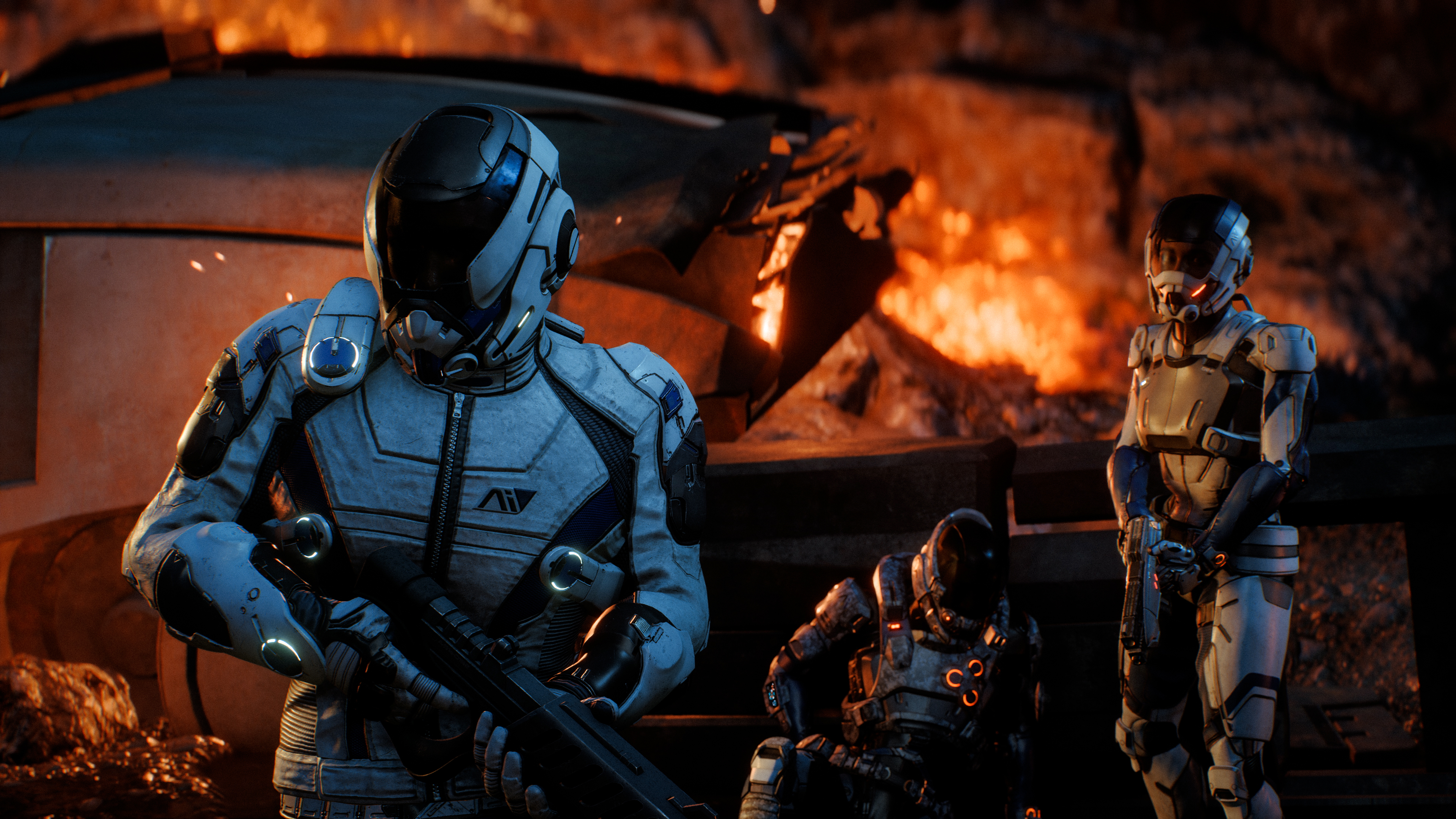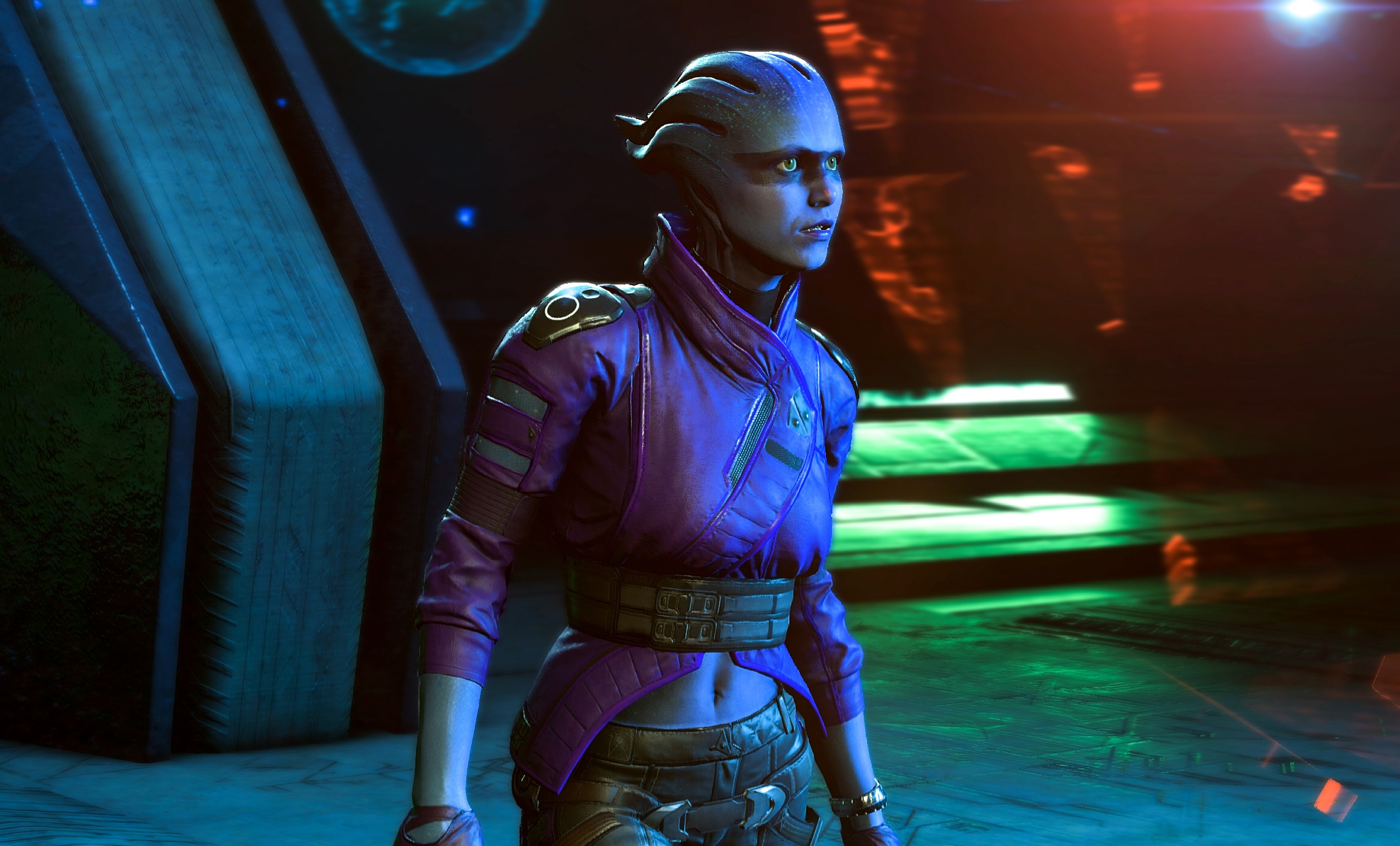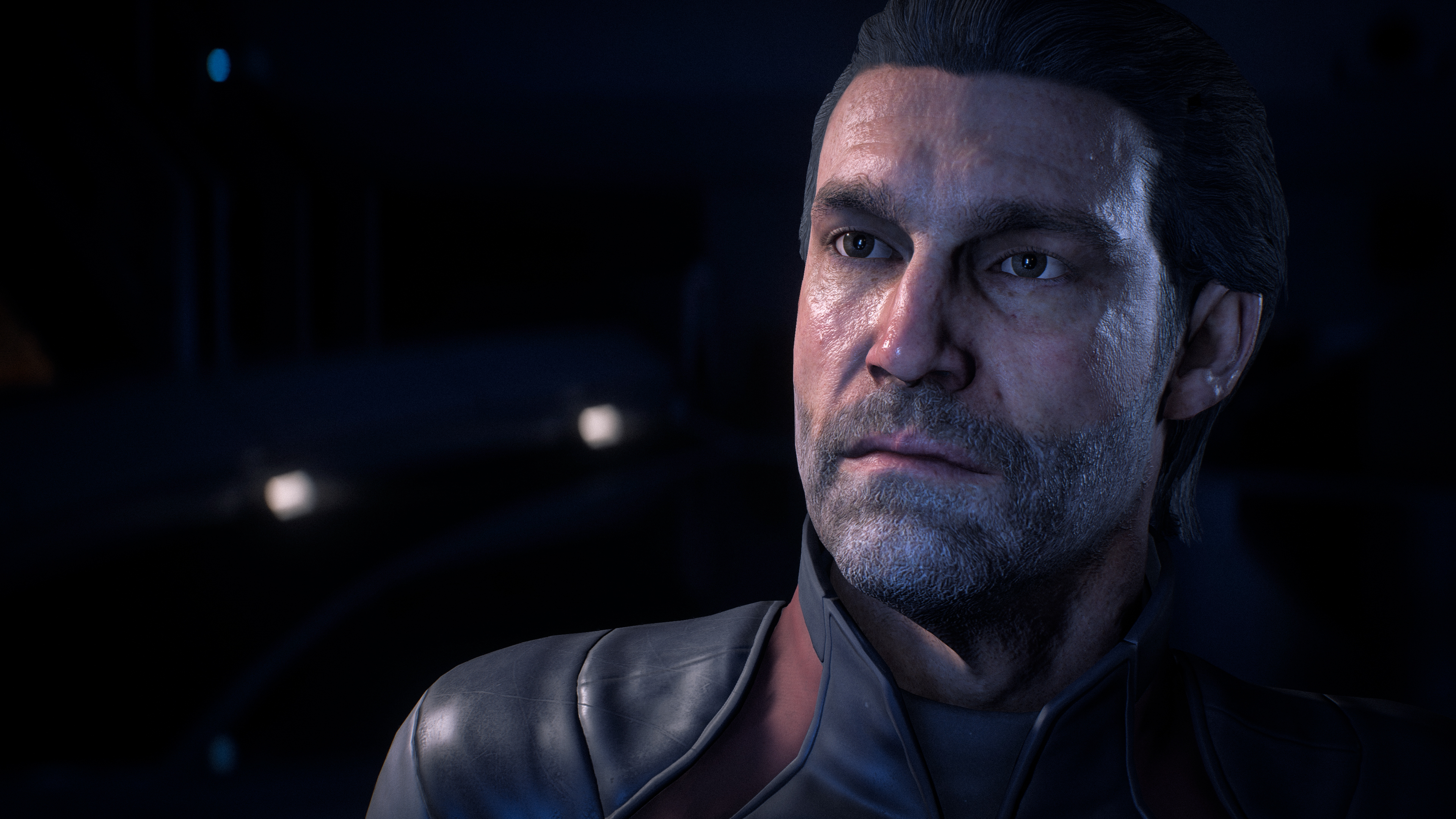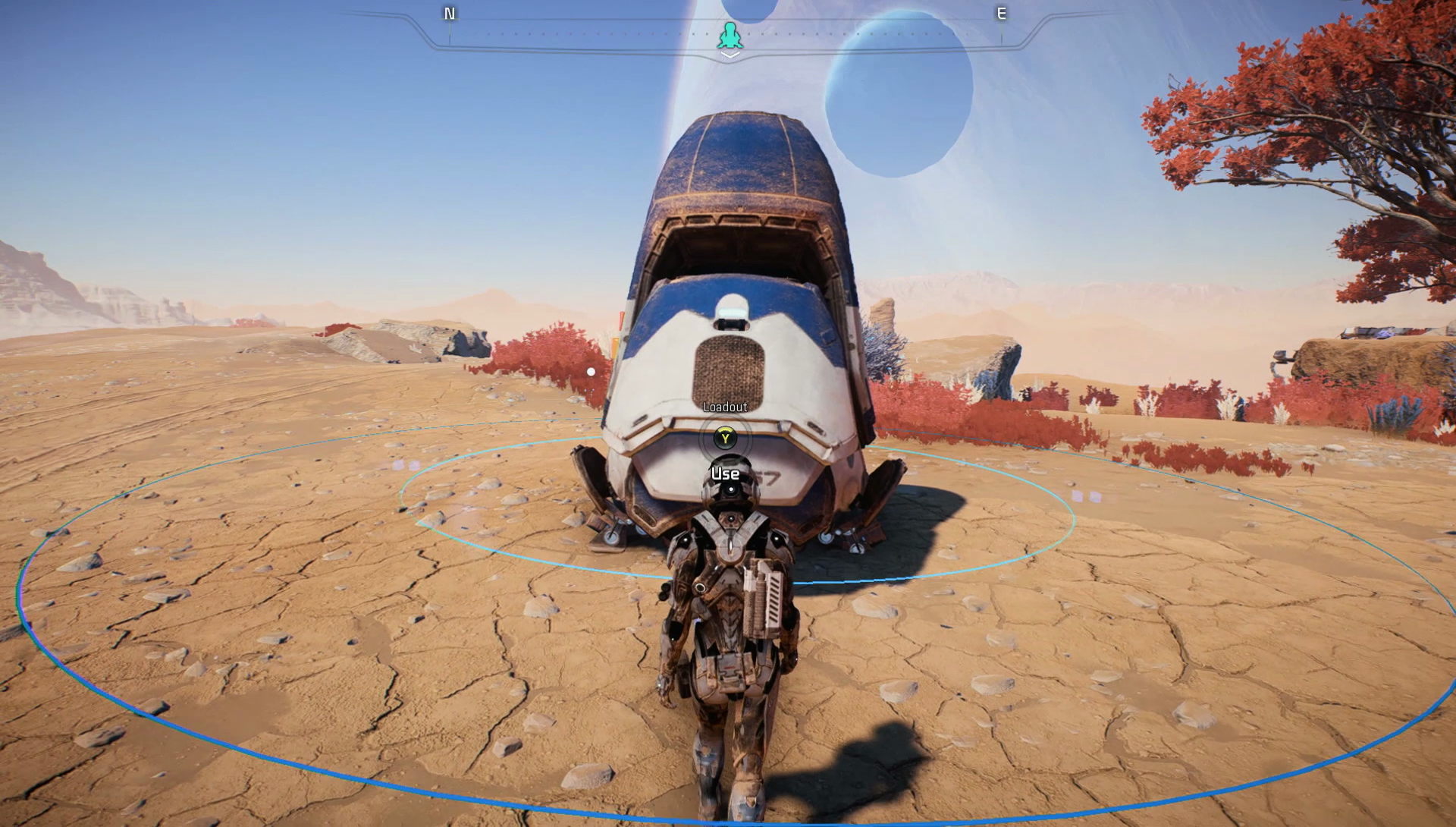Mass Effect: Andromeda hands-on: bigger, flashier, and very familiar
Three hours with Andromeda's combat, new crew, and open world exploration.

There must be problems in life that jetpacks can't solve, but I can’t think of many. The same goes for Mass Effect: you can't make a perfect action-RPG by slapping a jetpack onto your character's back, but you can sure as hell make a better action game. From my hands-on with Mass Effect: Andromeda, I can safely say that it now plays like the action game the series always wanted to be—a blend of third-person shooting and sweet sci-fi powers, but without the clumsiness that always made the original trilogy feel slightly out of its depth when the guns were drawn.

Our Mass Effect Andromeda news hub has a whole lot more Mass Effect for you, including another article about the first hour of the game and news about some the story and level cap.
Unlike Shepard, new hero Ryder turns on a dime, runs like an Olympic sprinter, and can rocket through the air or dodge across the ground thanks to that jetpack. Ryder can also jump and grab ledges, adding verticality to firefights for the first time. In one battle, I used the biotic ‘pull’ ability to float an enemy into the air on a ledge above me, then used the classic Vanguard charge to teleport-smash into his body in midair and in that moment I fell a little bit in love.
Reflecting on my three hours with Mass Effect: Andromeda, this pairing of high-speed movement and a platter of abilities is what I'm most excited about. Ryder is a pleasure to control, lively and kinetic, and all of the improvements Bioware has made to movement and animation and physics give the game that elusive quality—that smoothness—which you can feel through the keys. It's a critical step forward for Mass Effect, because that old combat certainly wasn't going to cut it.
But the improved shooting and space magic are only part of what’s exciting about Bioware's next space opera, which is so packed with features that it hoovers up genres and conventions like a seasoned space janitor. Andromeda is a sci-fi shooter with open(-ish) world exploration, a freeform class system, RPG progression, crafting, resource mining, and of course, romance.
Bioware has spent the past five years building a new galaxy. So it’s no surprise that after three hours I felt like I'd barely dipped my toes into Andromeda. But I saw enough to tell you that it's very familiar: prettier, yes, bigger, yes, but even in a new galaxy the characters and writing and framework still feel very Mass Effect. In some ways, that's disappointing. As reboots go, it could be bolder. But what makes me optimistic is which Mass Effect it feels most like: the first one.
The Andromeda iniative
"In a lot of our internal documentation, our meetings early on, the big theme for the game was 'Fulfill the promise of Mass Effect 1,' Andromeda lead designer Ian Frazier told me when I interviewed him last week. "Take what was good about Mass Effect 1, and what it aspired to be, and go, well, it's been 10 years. What can we do to take that and deliver above and beyond what was even possible back then?"
The big theme for the game was 'fulfill the promise of Mass Effect 1.'
Ian Frazier, lead designer
Andromeda's opening mission does a poor job of answering that question. As Andy wrote in his critique, the first hour of the game introduces you to a new alien race and immediately throws you into a firefight. Shepard’s background was military, while Ryder is meant to be an explorer, but you wouldn't know it from the intro.
The biggest gaming news, reviews and hardware deals
Keep up to date with the most important stories and the best deals, as picked by the PC Gamer team.
After that opening mission Bioware loaded up a save file that was hours ahead and put me in orbit around the planet Kadara, home to the spaceport shown in the first gameplay trailer. Here, finally, I started to see the glimmer of Mass Effect's original vision shine through.
The spaceport bustles with life, with Krogans and humans and Asari milling about, and as I jog through town I spot a couple potential sidequests, including an intriguing murder mystery. I walked off the Tempest, Andromeda's take on the Normandy, with two crewmembers, a Krogan named Drack and a female Turian named Vetra, who tell me they have some business to take care of and the less I know, the better. It's an intriguing story moment that I hope Andromeda is full of—the hint of companions having their own shit going on broadens Andromeda's world. Not everything revolves around your actions. And maybe sometime I'll get pulled into those conflicts.
I meet a contact in the local bar, who tells me the person I need to talk to is being held by local bigshot Sloane Kelly. We have a tense discussion, but unlike the trailer above, guns stay in their holsters. Here I get a feel for Andromeda's new dialogue system. In place of the Paragon and Renegade paths are four tones: emotional, logical, casual, and professional. With Kelly there's an emotional path I could take, bargaining for the life of the prisoner I want to talk to. But I don't. I want the information, and promise not to make any trouble.
That goes over well, but I can tell there's a deeper story here, a larger cause that I may be more invested in if I hadn't jumped into the middle of the game.
The lip-syncing and facial animations look fine to my eye—not quite as stiff or doll-like as they did in the trailer above, which caused some concern back in December. In the game's first moments, when Ryder first awakens from cryosleep, I immediately noticed how much better the facial animation was compared to Mass Effect 3. There's more movement around the jaw and cheeks, creating nuanced facial expressions even when characters aren't talking.
So the good news is that the characters look lifelike now, but at best Andromeda only feels like it's been brought up parity with the animations of other big budget games. From what I've seen, it doesn't come close to rivaling the animation or performances of The Witcher 3. The characters also have a slightly more cartoony look to them—blobs of hair, more exaggerated eyes. The models aren't ugly, but the style isn't pushing for maximum realism or detail. None of these things stop Andromeda from being a pretty game, especially in combat when the particle effects are flying around, but it doesn't feel like Bioware is pushing Frostbite to the limits the same way DICE does.

Later I return to the Tempest and my crew gather to discuss several potential quests we have to go on, each arguing for what they think should be the priority. If this is a common occurrence, it's a really cool way to develop these characters while also doling out bits of story. It's a combination of new information and references to events from earlier in the save file that are new to me. These missions would take me off-planet, but instead I choose to stay and explore Andromeda's most significant new feature: planetary exploration.
The return of crafting and the open world
This new feature is also an old feature. The "promise" of the original Mass Effect was the idea that planetary exploration would be an amazing experience—that you could have compelling RPG stories in hubs like Kadara, and the sense of awe and discovery that comes from landing on virtually any planet in the galaxy and finding out what weirdness was down there. But driving the Mako around those procedurally generated wastelands ended up being about as much fun as taking a safari in a coma. So Mass Effect 2 and 3 abandoned the idea.
Andromeda's planetary surfaces aren't procedurally generated. They were designed by hand, and Frazier shied away from describing them as open world.
"We tried to not even think of ourselves as an open world game," he said. "Open, yes. Explorative, yes. But not in that exact mold. We instead looked at Mass Effect 1, examples like Novaria and said 'okay, if you built that now, and you could throw more time and money and energy at it than we could at the time, what would that look like?' Imagine a Novaria where you find a whole lot more than just driving from point A to point B, from the cool big hub and the other cool big hub."

The surface of Kadara is pretty as I cruise across it in the Nomad, Andromeda's replacement for the Mako. It feels just alien enough, with a few giant mushroom trees (it's always mushrooms, isn't it?) and bits of coral-like flora scattered across the surface. There's some scant alien wildlife—all of which is aggressive, making me wonder if everything in this galaxy is carnivorous—and frequent outposts manned by dudes guys who attack me, though I haven't quite picked up on why. As we drive around my companions remark on the scenery and the mission we're on, which is a nice touch but doesn't work as well as it should. Several times they reference things I don't spot, making the conversation hard to follow.
The Nomad does remind me of the Mako, and I have a few silly moments driving it over rocks and getting momentarily stuck, but it's not as floaty, and driving in reverse gets me back on track. On Andromeda's hand-built planets, I don't expect to relive the frustrations of pushing the Mako up and over craggy mountains through sheer force of will. The Nomad doesn't seem up for absurd acrobatics.
Guns drawn
I also don't use my ride as a combat vehicle, which I often had to in the original Mass Effect. Every outpost gives me an opportunity to hop out and try the new weapons I modified before leaving the Tempest. The entire weapon system feels very Mass Effect 1, with different versions of guns like the N7 Crusader VII having varying stats for damage, clip size, rate of fire, accuracy, and so on. You'll collected blueprints that allow you to build new guns, and can augment them at an R&D station on the Tempest. I loved this in the original Mass Effect—weird combinations were so fun to play with, like my beloved shotgun that fired a single explosive round for massive damage before overheating. In Andromeda I turned my assault rifle into a beam weapon and gave my shotgun an automatic fire module.
The laser beam ended up being piddly, but the latter worked well when I combined it with the biotic charge to warp across the battlefield and bodyslam my enemies. This is when I got a real feel for Andromeda's combat and started mixing up my abilities.
As this trailer for the combat system explains, there are no classes, this time around—you can put points into any skill you want, an awesome bit of freedom that I took advantage of to immediately diversify.
All of Andromeda's skills either set up a combo or detonate a combo, so I picked the tech skill cryo beam to freeze enemies and the biotic skill lance to detonate combos. This turned out to be an absolute blast—holding down the key for cryo beam literally shoots a continuous beam of ice out of your hands, while lance deals a quick blast of biotic energy that detonates combo primers. Charge also detonates combos, which means it pairs extremely well with cryo beam or another debilitating skill like biotic pull.
Another video shows off many of these combos, and also explains the new Profile system, the replacement for classes. Instead of locking you into certain skills, it rewards you with bonus stat boosts based on how you choose to specialize.
Guns don't feel as satisfying to fire as more focused first-person shooters like Battlefield, or even as punchy as they do in Max Payne 3, which came out the same year as the last Mass Effect. They have none of the physicality, recoil, or heavy sound design of the best-feeling shooters. I don't think Mass Effect necessarily needs those things, especially when the weapon augmentation system lets you change how any gun feels and fires. Biotics are where the fun is, for me, but gun feedback is the one area where Andromeda's combat hasn't seen great improvement.
Andromeda's new cover system, which lets you sidle up against any surface, is a welcome change from the ubiquitous squat-and-pop of last generation's third-person shooter arenas, though outposts like the ones scattered around Kadara still have some of that sort of cover. The new system is barely "sticky," making it easy to enter and leave cover. I'm torn on it—I welcome the flexibility, and Andromeda's jetpack-enhanced mobility means I'll likely to want to spend far less time in cover, period. But it's actually hard to even tell when you're in cover, which is likely why Bioware decided to place a large shield icon at the bottom of the UI whenever you're properly pressed up against a wall.

As I explore, drop pods descend from the sky to let me mine certain areas for resources, and they serve as convenient waypoints for fast travel; I can warp back to the first one, outside Kadara's spaceport, instead of driving all the way back. This slice of Kadara obviously isn't meant to be planet-sized, but it's a large enough space to play host to a few hours of sidequests and resource gathering.
Bioware isn't talking about how many planets there are like this in Andromeda, and it's impossible to know how unique they'll feel. But on first impression, they're a hell of a lot better than Mass Effect 1's, and nothing like No Man's Sky—these are crafted play spaces, with enemies and quests strategically placed, rather than vast contemplative spaces to explore accompanied by nothing more than a cool soundtrack.
One small step
I didn't play enough Andromeda to know what I'll ultimately make of its new crew, or to get a feel for the quality of the sidequests, or even to scope out its new villain, the Kett's Archon. Part of me is disappointed he exists at all. As Frazier told me, the Archon is hunting you because you can interact with alien "remnant" technology spread across the galaxy, which is literally a sci-fi trope I remember saying, some months ago, that I hoped Mass Effect: Andromeda would avoid. But no such luck.
Ryder didn't need to be "special." Exploring space with a crew of aliens is special enough. It wasn't an original idea in the first Mass Effect, and it isn't an original idea 10 years later. Again, I wish Bioware had been bolder.
But when I remember playing Mass Effect, I barely remember interacting with alien relics or the fuzzy reasoning behind who could use magic space powers and who couldn't. I remember that spirit of exploration and possibility, an optimistic galaxy full of characters I grew to love and an avatar I wanted to mold. That's what Andromeda is shooting for, and it has a far deeper combat system to pair with all that dialogue this time.
As an RPG, there's a lot riding on the crew, sidequests, and how well Bioware's writers use the new tone system. Unless the main story goes in surprising directions, what I've seen of it so far is the least interesting thing about Andromeda, with a disappointingly predictable setup and a new big bad hunting you down. But like I was a decade ago, I'm still drawn to the romance of a whole new galaxy to explore, and new characters to explore it with. And this time I have a jetpack.

Wes has been covering games and hardware for more than 10 years, first at tech sites like The Wirecutter and Tested before joining the PC Gamer team in 2014. Wes plays a little bit of everything, but he'll always jump at the chance to cover emulation and Japanese games.
When he's not obsessively optimizing and re-optimizing a tangle of conveyor belts in Satisfactory (it's really becoming a problem), he's probably playing a 20-year-old Final Fantasy or some opaque ASCII roguelike. With a focus on writing and editing features, he seeks out personal stories and in-depth histories from the corners of PC gaming and its niche communities. 50% pizza by volume (deep dish, to be specific).

